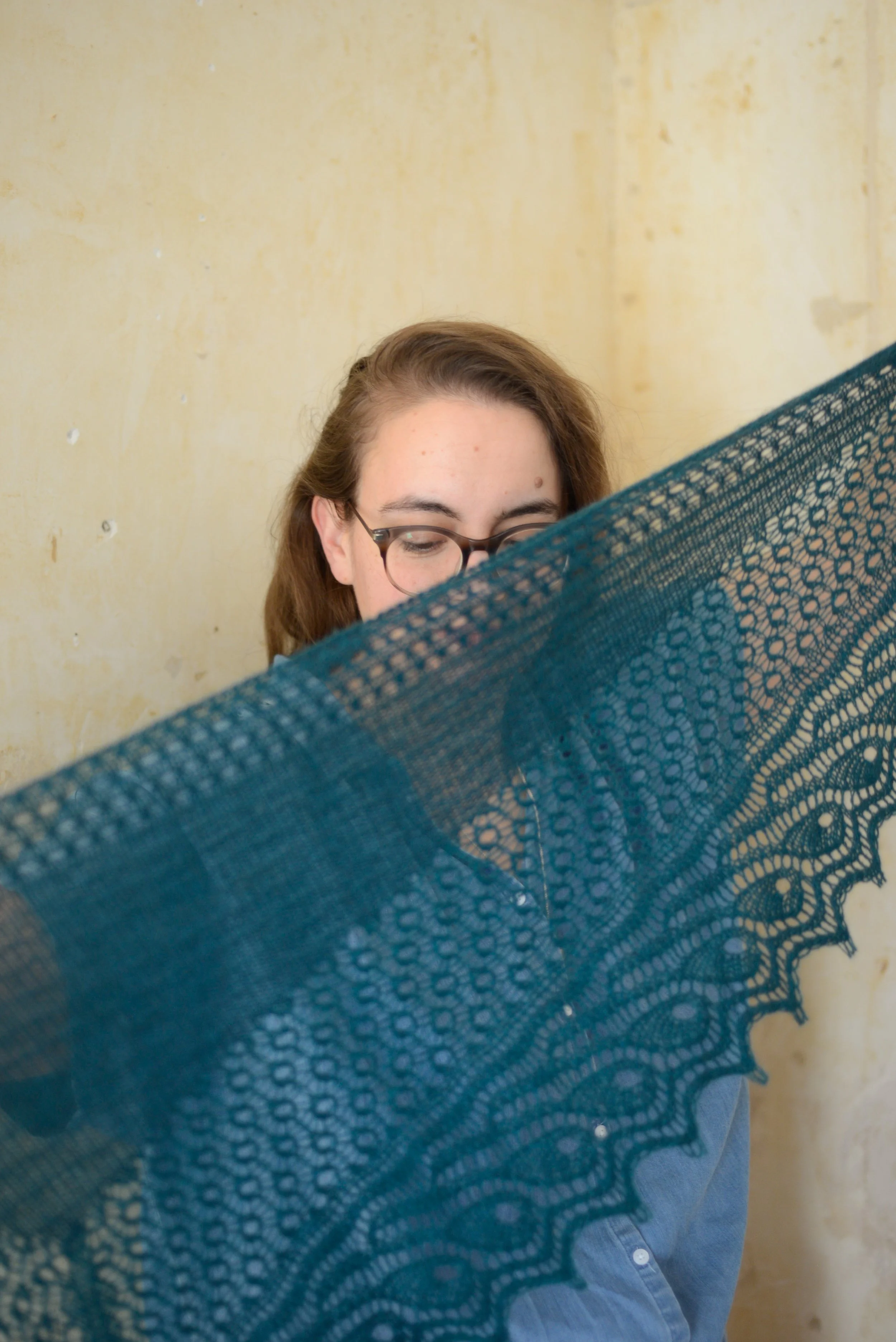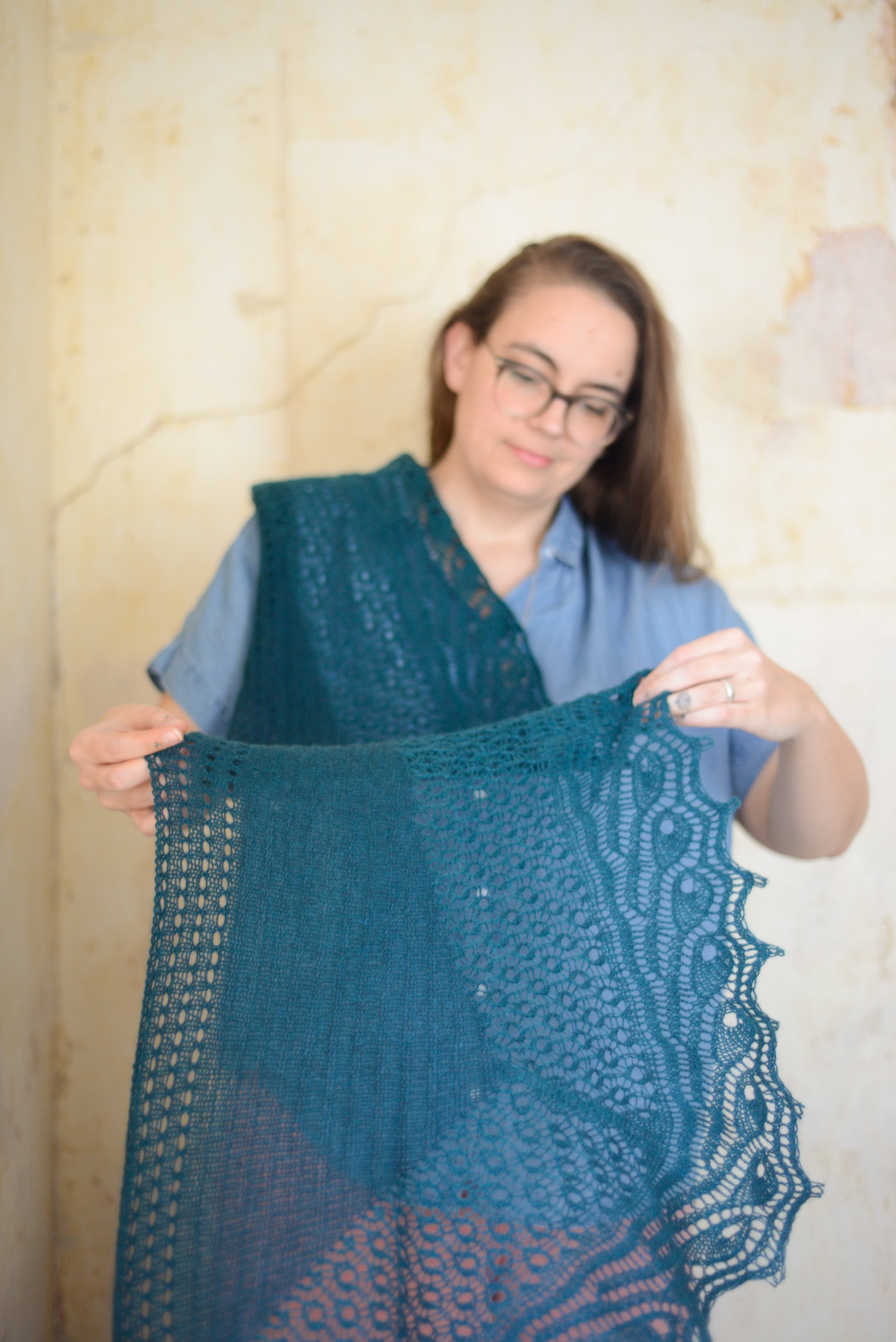 Image 1 of 12
Image 1 of 12

 Image 2 of 12
Image 2 of 12

 Image 3 of 12
Image 3 of 12

 Image 4 of 12
Image 4 of 12

 Image 5 of 12
Image 5 of 12

 Image 6 of 12
Image 6 of 12

 Image 7 of 12
Image 7 of 12

 Image 8 of 12
Image 8 of 12

 Image 9 of 12
Image 9 of 12

 Image 10 of 12
Image 10 of 12

 Image 11 of 12
Image 11 of 12

 Image 12 of 12
Image 12 of 12













Morven Shawl
25% off through April 17th with the code “OMGLACE”!
Traditional lace patterns, non-traditional shape, timeless beauty.
Finished Measurements
64 3⁄4” (164.5 cm) wingspan, 22” (56 cm) depth at deepest point
Yarn
High Mountain Yak Yarn by NomadNoos (100% high mountain yak fiber; 290 yds (265 m) / 1.76 oz (50 g)): 2 skeins in Don’t Tell Your Secret Wish, or approximately 475 yds (435 m) of light fingering weight or heavy laceweight yarn
Needles
32-40” (81-101 cm) circular needle or straight needles Suggested size: US 5 (3.75 mm)
Gauge
17 sts and 40 rows = 4” (10 cm) in Welt Pattern, after lace blocking
Construction Notes
Morven starts with the border, worked sideways until its entire length is reached. From there, stitches are picked up into the yarnovers at the inside edge of the border, and the bird’s eye lace pattern is worked across these stitches, with decreases occurring for shaping at the off-center spine and the edges. These decreases help shape the border from a straight rectangle into a right angle. Finally, short rows are worked back and forth over these remaining stitches to fill in the remainder of the shawl.
25% off through April 17th with the code “OMGLACE”!
Traditional lace patterns, non-traditional shape, timeless beauty.
Finished Measurements
64 3⁄4” (164.5 cm) wingspan, 22” (56 cm) depth at deepest point
Yarn
High Mountain Yak Yarn by NomadNoos (100% high mountain yak fiber; 290 yds (265 m) / 1.76 oz (50 g)): 2 skeins in Don’t Tell Your Secret Wish, or approximately 475 yds (435 m) of light fingering weight or heavy laceweight yarn
Needles
32-40” (81-101 cm) circular needle or straight needles Suggested size: US 5 (3.75 mm)
Gauge
17 sts and 40 rows = 4” (10 cm) in Welt Pattern, after lace blocking
Construction Notes
Morven starts with the border, worked sideways until its entire length is reached. From there, stitches are picked up into the yarnovers at the inside edge of the border, and the bird’s eye lace pattern is worked across these stitches, with decreases occurring for shaping at the off-center spine and the edges. These decreases help shape the border from a straight rectangle into a right angle. Finally, short rows are worked back and forth over these remaining stitches to fill in the remainder of the shawl.
25% off through April 17th with the code “OMGLACE”!
Traditional lace patterns, non-traditional shape, timeless beauty.
Finished Measurements
64 3⁄4” (164.5 cm) wingspan, 22” (56 cm) depth at deepest point
Yarn
High Mountain Yak Yarn by NomadNoos (100% high mountain yak fiber; 290 yds (265 m) / 1.76 oz (50 g)): 2 skeins in Don’t Tell Your Secret Wish, or approximately 475 yds (435 m) of light fingering weight or heavy laceweight yarn
Needles
32-40” (81-101 cm) circular needle or straight needles Suggested size: US 5 (3.75 mm)
Gauge
17 sts and 40 rows = 4” (10 cm) in Welt Pattern, after lace blocking
Construction Notes
Morven starts with the border, worked sideways until its entire length is reached. From there, stitches are picked up into the yarnovers at the inside edge of the border, and the bird’s eye lace pattern is worked across these stitches, with decreases occurring for shaping at the off-center spine and the edges. These decreases help shape the border from a straight rectangle into a right angle. Finally, short rows are worked back and forth over these remaining stitches to fill in the remainder of the shawl.